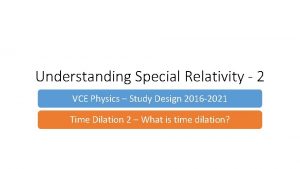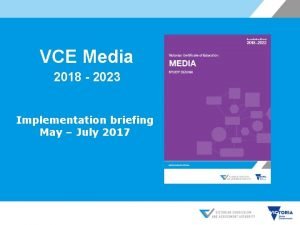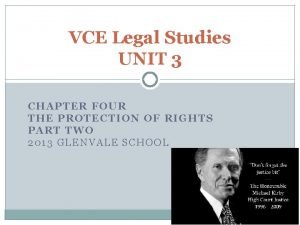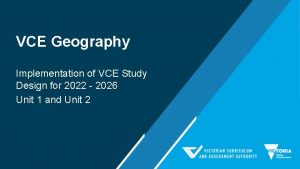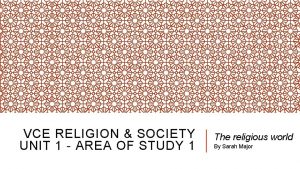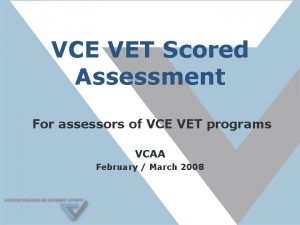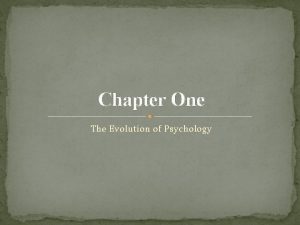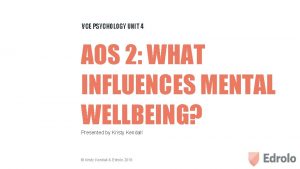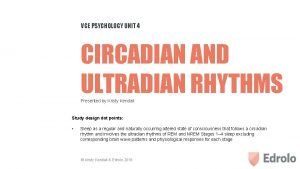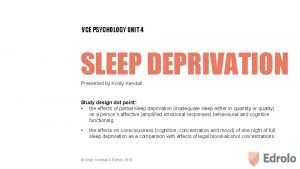VCE Psychology Unit One Area of Study 2






















- Slides: 22

VCE Psychology Unit One Area of Study 2: Lifespan Psychology CHAPTER 5: LIFESPAN DEVELOPMENT http: //www. youtube. com/watch? v=XHb 7 Ig 3 y. Pg. I http: //www. youtube. com/watch? v=QIPQHn_z. P 9 w

AOS 2: Lifespan Development � Chap 4: Lifespan Development � Chap 5: Theories on Psychological Development � Chap 6: Mental Illness Across Lifespan: Autism ADHD Anorexia Anxiety Schizophrenia Dementia

Chapter 4: Lifespan Development � Lifespan Development: Age related changes that occur from birth, throughout a person’s life, into and during old age. � Maturation: The orderly and sequential developmental changes which occur in the nervous system and other bodily structures controlled by our genes. � ‘Principle of readiness’ Nerves, bones, muscles need to be developed enough for the behaviour to occur

Lifespan � Infancy – birth to 2 years � Childhood – 2 to 10 years � Adolescence – 10 to 20 years � Early adulthood – 20 to 40 years � Middle age – 40 to 65 years � Older age – 65 years and beyond Watch ‘the developing child’ http: //www. learner. org/series/discoveringpsychology/05/e 05 expa nd. html

Task �Read pages 135 -137 Complete Learning Activity 4. 2

Areas of lifespan Development � Physical development: changes in the body and its various systems. � Social Development: involves changes in an individual’s relationships with other people and their skills in interacting with others � Cognitive development: involves changes in an individual’s mental ability � Emotional development: involves changes in how an individual experiences different feelings and how these feelings are expressed.

Human development is influenced by simultaneously occurring changes in each area Social Development Cognitive Development Emotional Development Physical Development

Heinz Dilemma �A woman was near death from a special kind of cancer. There was one drug that. . . So Heinz got desperate and broke into the man's store to steal the drug for his wife. Should Heinz have broken into the laboratory to steal the drug for his wife? Why or why not?

Task �Complete Learning Activity 4. 3 Visual Presentation-Personal Timeline

How Development proceeds: 1. Continuous V Discontinuous � Continuous Development: gradual and ongoing changes throughout the lifespan without sudden Adulthood shifts, with abilities in the earlier stages of development providing the basis of skills and abilities required for the next stages. � Discontinuous: involves distinct and separate stages, with different kinds of abilities occurring Infancy in each stage. Specific ways of thinking, feeling or Adulthood socially interacting have identifiable start and end points. Infancy

2. Sequential Nature of Development � The development of many thoughts, feelings and behaviours occur in an orderly sequence. Sequences of development usually begin with simple thoughts, feeling and behaviours and progress to more complex ones. For example: -A baby moves from squealing and gurgling through to uttering individual words and then onto using sentences - A child learning to count and then progressing to adding numbers together

3. Individual Differences in Development �No two individuals develop at exactly the same rate or in exactly the same way, even if they are identical twins

Nature vs Nurture � The nature versus nurture debate concerns the relative importance of an individual's innate qualities ("nature, " i. e. nativism, or innatism) versus personal experiences ("nurture, " i. e. empiricism or behaviourism) in determining or causing individual differences in physical and behavioural traits. � http: //www. youtube. com/watch? v=d. Enk. Y 2 ia. Kis � Complete Learning Activity 4. 9 on page 146

Sensitive Periods �Periods of rapid change when individual is more vulnerable to the environment �Eg: second 6 months of life sensitive to attachment �Eg: 1. 5 -3 years sensitive to language acquisition �https: //www. youtube. co m/watch? v=d. Enk. Y 2 ia. Kis

Different Perspectives on Development Biological Behavioural Cognitive Socio-cultural

Task �Complete Learning Activity 4. 14 on page 153

Research Methods for Developmental Studies � Cross sectional-selects & compares groups of participants of different ages over a short period of time � Longitudinal- a long term investigation that follows the same group of people over an extended period of time.

Research Methods for Developmental Studies �Cohort-Sequential- combines the crosssectional & Longitudinal. �Eg 3 cohorts of adolescents aged 14, 16 & 18 every 2 years over a 4 year period.

Advantages & Disadvantages Longitudinal Advantages � Permanence in development over time Disadvantages � Expensive � Takes time with participants (and researchers) not being available Cross Sectional Advantages: � relatively inexpensive � easy to undertake � not too time-consuming. Disadvantages: � Differences maybe due to other variables Eg: generational influences

Twin Studies � using identical (mono-zygotic) and non-identical (fraternal/dizygotic) twins as participants. � Identical especially for nature vs nurture BUT danger (eg more likely to be treated the same by parents) � Personality and intelligence investigations Discuss 4. 17 ranking

Adoption Studies & Selective Breeding Adoption Studies � Children raised by different parents – nature vs nurture � IQ score studies indicate heredity plays a large role Selective Breeding � Using animals with short gestations to study traits longitudinally, with control of genes � Unethical in humans but can use

Tasks �Complete Learning Activity 4. 20
 Study design psychology
Study design psychology Edrolo psychology
Edrolo psychology Vce psychology scientific poster
Vce psychology scientific poster Vce outdoor and environmental studies
Vce outdoor and environmental studies Vce drama
Vce drama Physics study design
Physics study design Vce japanese study design
Vce japanese study design Vce study score bell curve
Vce study score bell curve Vce art study design
Vce art study design Theatre studies study design
Theatre studies study design Visual communication design study design
Visual communication design study design Media codes and conventions
Media codes and conventions Legal studies study design
Legal studies study design Vcaa hhd
Vcaa hhd Vce physics poster
Vce physics poster Vce literature unit 1 and 2
Vce literature unit 1 and 2 Vce physics unit 1 and 2
Vce physics unit 1 and 2 Module 79 ap psychology
Module 79 ap psychology One god one empire one emperor
One god one empire one emperor One one one little dogs run
One one one little dogs run One king one law one faith
One king one law one faith One god one empire one emperor
One god one empire one emperor One ford behaviors
One ford behaviors





